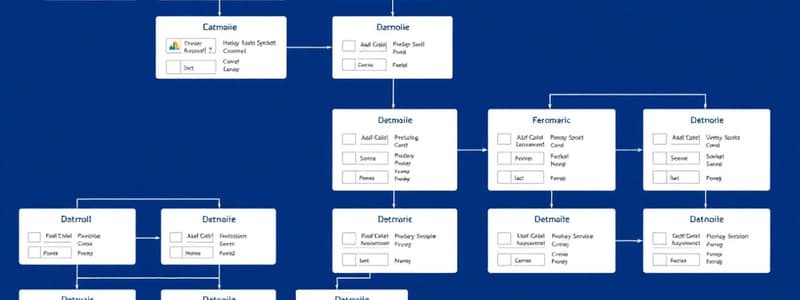Podcast
Questions and Answers
Which of the following is a key difference between a database system and a file system for managing data?
Which of the following is a key difference between a database system and a file system for managing data?
- Database systems enforce data integrity and consistency constraints, while file systems offer minimal control over data relationships. (correct)
- File systems provide data independence, abstracting the physical storage from the logical structure, unlike database systems.
- Database systems primarily focus on storing multimedia files, whereas file systems handle structured data.
- File systems support complex queries and transactions, while database systems are limited to simple data retrieval.
What does data independence in a database system primarily ensure?
What does data independence in a database system primarily ensure?
- Only authorized users can access the database, ensuring complete data security.
- Applications are tightly coupled with the physical storage details, maximizing performance.
- Data is stored in a proprietary format that is specific to the database system.
- Changes in the physical storage of data do not affect the applications accessing that data. (correct)
A database schema defines which aspect of a database?
A database schema defines which aspect of a database?
- The logical structure of the database, including tables, relationships, and constraints. (correct)
- The actual data stored in the database at a particular moment.
- The users who have access to the database and their respective permissions.
- The physical location of the data files on the storage device.
What is the main purpose of a Data Definition Language (DDL) in a database system?
What is the main purpose of a Data Definition Language (DDL) in a database system?
What is the primary role of a Data Manipulation Language (DML) in a database system?
What is the primary role of a Data Manipulation Language (DML) in a database system?
In the context of database systems, what does the term 'instance' refer to?
In the context of database systems, what does the term 'instance' refer to?
Which of the following is a key component of the Entity-Relationship (ER) model?
Which of the following is a key component of the Entity-Relationship (ER) model?
What is the purpose of mapping constraints in the ER model?
What is the purpose of mapping constraints in the ER model?
In ER diagrams, what does an attribute represent?
In ER diagrams, what does an attribute represent?
What is the significance of 'Overall Database Structure'?
What is the significance of 'Overall Database Structure'?
Flashcards
Database System
Database System
A software system that manages databases, providing controlled access, integrity, and security.
File System
File System
A traditional way to store data in individual files, lacking centralized control and often leading to redundancy and inconsistency.
Schema
Schema
A description of the database structure and constraints.
Instance
Instance
Signup and view all the flashcards
Data Independence
Data Independence
Signup and view all the flashcards
Data Definition Language (DDL)
Data Definition Language (DDL)
Signup and view all the flashcards
Data Manipulation Language (DML)
Data Manipulation Language (DML)
Signup and view all the flashcards
ER Diagram
ER Diagram
Signup and view all the flashcards
Mapping Constraints
Mapping Constraints
Signup and view all the flashcards
Entity Relationship Model
Entity Relationship Model
Signup and view all the flashcards
Study Notes
- Database systems offer advantages over file systems
- They include data integrity, data consistency, security, and efficiency
- A database system comprises data, hardware, software, and users
- Data models define how data is structured and related within a database
- Schemas define the structure, while instances are the actual data in the database at a specific time
- Data independence allows changes to the schema without affecting the application
- Database languages include DDL (Data Definition Language) for defining the schema
- DML (Data Manipulation Language) is for manipulating data
- The overall database structure includes the database itself, metadata, and application programs
- The Entity-Relationship (ER) model is used for data modeling
- It includes entities, attributes, and relationships
- ER diagrams use specific notations to represent entities, attributes, and relationships
- Mapping constraints specify how entities are related in a relationship
Studying That Suits You
Use AI to generate personalized quizzes and flashcards to suit your learning preferences.




